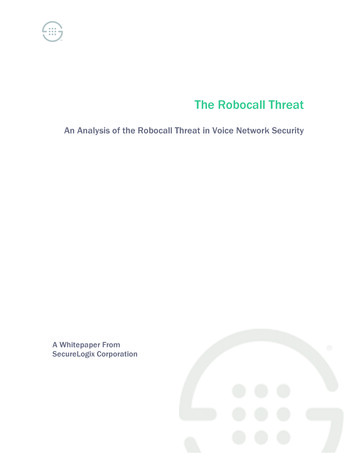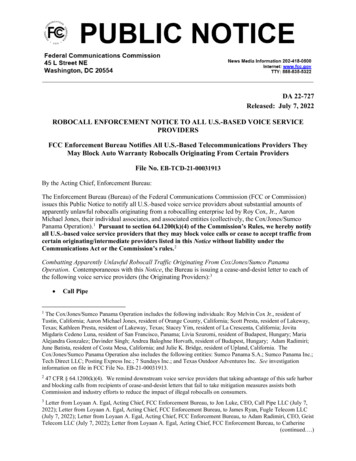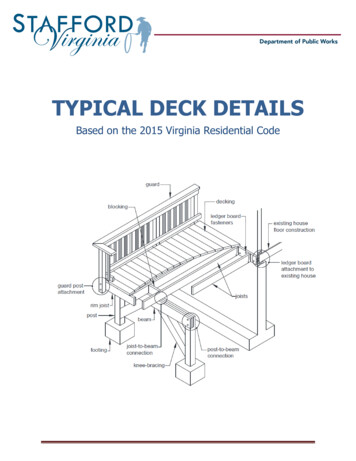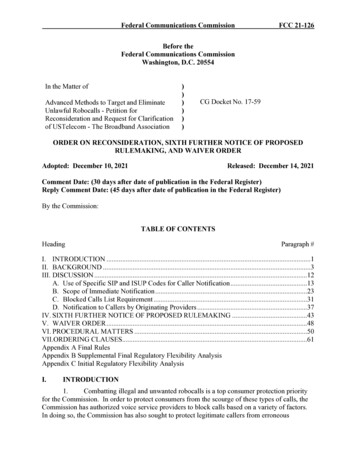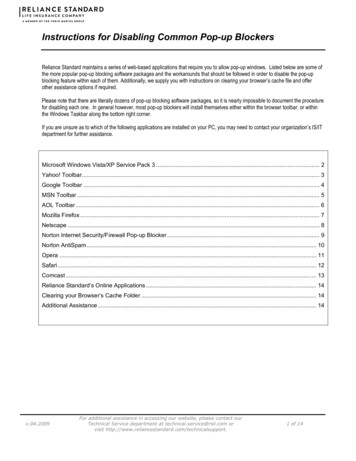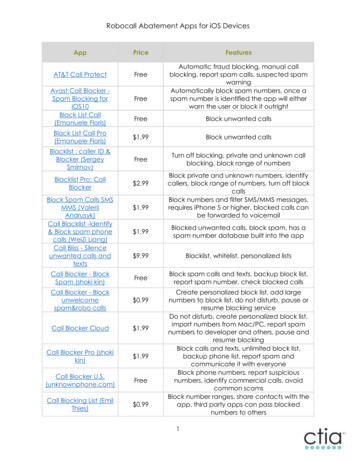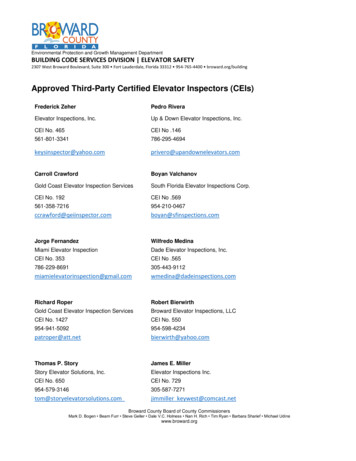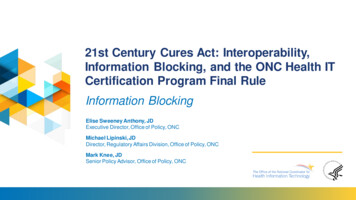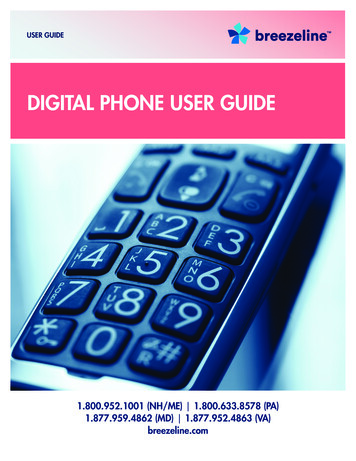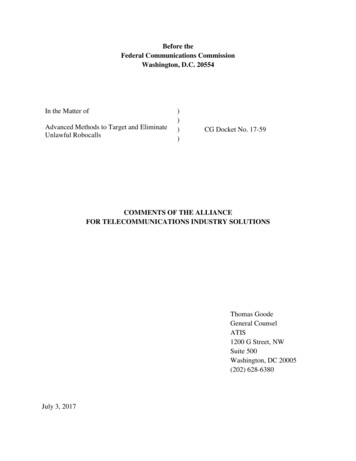
Transcription
Before theFederal Communications CommissionWashington, D.C. 20554In the Matter ofAdvanced Methods to Target and EliminateUnlawful Robocalls))))CG Docket No. 17-59COMMENTS OF THE ALLIANCEFOR TELECOMMUNICATIONS INDUSTRY SOLUTIONSThomas GoodeGeneral CounselATIS1200 G Street, NWSuite 500Washington, DC 20005(202) 628-6380July 3, 2017
TABLE OF CONTENTSSUMMARY.iiiCOMMENTS.1I. BACKROUND.2II. COMMENTS.2A. Definition of “Illegal Robocall”.4B. Blocking at Subscriber’s Request.5C. Blocking Unassigned Numbers.61. Invalid Numbers.62. Unallocated Numbers.73. Allocated but Unassigned Numbers.8D. Internationally Originated Calls.9E. Subscriber Consent.10F. Call Completion Rates.10G. Objective Standards to Identify Illegal Calls.10H. Safe Harbor for the Blocking of Calls Identified Using Objective Standards.11I. Protections for Legitimate Callers.12III. CONCLUSION.13ii
SUMMARYATIS applauds the Commission’s efforts to support industry initiatives to mitigate illegalrobocalling and caller ID spoofing. ATIS believes that the NPRM and NOI are appropriatelyfocused on providing clarity about available mitigation tools, rather than creating mandates.ATIS generally supports the Commission’s proposals to allow providers to block callsfrom unassigned numbers, including numbers that: (1) are invalid under the North AmericanNumbering Plan (NANP), including numbers with unassigned area codes; (2) have not beenallocated by the North American Numbering Plan Administrator (NANPA) to any provider; and(3) are allocated to a provider, but not currently assigned to a subscriber. However, as explainedmore fully in these comments, there are complexities related to blocking these categories ofnumbers that must be addressed.Regarding the application of the robocalling mitigation techniques to internationallyoriginated calls purportedly originated from NANP numbers, ATIS supports this proposal, butacknowledges that this will not resolve in any significant way the challenges associated withrobocalls and caller ID spoofing originating outside of the U.S.ATIS also supports the Commission’s proposals to: (1) not require providers to obtain anopt-in from subscribers in order to block calls as proposed in the NPRM; and (2) exclude callsblocked in accordance with the robocall mitigation techniques proposed in this proceeding fromcalculation of providers’ call completion rates.While ATIS supports industry efforts to implement SHAKEN, it notes that the blockingof calls with unauthenticated caller ID will not be an effective mitigation technique until there issufficient saturation of appropriately signed calls. ATIS further notes that SHAKEN is one ofmany tools that the industry should consider as part of a layered approach to addressing thisproblem. ATIS believes that the industry is in the best position to determine when caller IDauthentication would be added to the industry’s toolkit of mitigation strategies to block calls.ATIS supports the Commission’s efforts to provide certainty that utilization of therobocall mitigation techniques discussed in this proceeding will not be deemed to have violatedCommission rules or the Communications Act and supports the provision of a safe harbor toprotect service providers.Finally, ATIS agrees with the Commission’s suggestion that providers create a “whitelist” of legitimate callers who give them advanced notice, but recommends that the industryshould have the flexibility to create such a list, but not be required to continue to support it if badactors get access to and begin to spoof the numbers on this list. ATIS also supports theimplementation of a process to allow legitimate callers to notify providers when their calls areblocked and to require providers to cease blocking calls when they learn that the calls arelegitimate.iii
Before theFederal Communications CommissionWashington, D.C. 20554In the Matter ofAdvanced Methods to Target and EliminateUnlawful Robocalls))))CG Docket No. 17-59COMMENTS OF THE ALLIANCE FORTELECOMMUNICATIONS INDUSTRY SOLUTIONSThe Alliance for Telecommunications Industry Solutions (ATIS), on behalf of itsIndustry Numbering Committee (INC), Next Generation Interconnection Interoperability Forum(NGIIF), and Packet Technologies and Systems Committee (PTSC), hereby submits thesecomments in response to Notice of Proposed Rulemaking (FNPRM) and Notice of Inquiry (NOI),released May 17, 2017, in the above-referenced docket. As a key stakeholder in the developmentof technical and operational standards pertaining to unlawful robocalling, ATIS is pleased tohave the opportunity to respond to the comments in this proceeding.I.BACKROUNDATIS is a global standards development and technical planning organization thatdevelops and promotes worldwide technical and operations standards for information,entertainment, and communications technologies. INC addresses and resolves industry-wide issues associated with planning,administration, allocation, assignment, and use of the North American Numbering Plan(NANP) numbering resources within the NANP area.NGIIF provides an open forum to encourage the discussion and resolution of industrywide issues associated with the operational aspect of telecommunications network1
II.interconnection and interoperability, and the exchange of information concerning relevanttopics, such as network architecture, management, testing and operations, and facilities.PTSC develops and recommends standards and technical reports related to services,architectures, and signaling. PTSC’s work programs focus on issues such as EmergencyTelecommunications Service (ETS), cybersecurity, IP-to-IP interconnection, lawfullyauthorized electronic surveillance and the evolution of the public switched telephonenetwork (PSTN).COMMENTSATIS applauds the Commission’s efforts to support industry initiatives to mitigate illegalrobocalling and caller ID spoofing. As has been explained previously, the industry has beenworking diligently to develop robocall mitigation techniques for many years. ATIS’ work todevelop operational and technical guidance regarding mass calling events, robocalling, and callauthentication started years ago as part of the industry’s significant efforts to foster networkreliability and improve the customer’s experience.The challenges associated with robocalling are not the result of a lack of industry interestor efforts regarding robocalling but rather are the result of the complexities associated with thismatter. The existence of legal and legitimate uses of both robocalling and caller ID spoofing inthe U.S. means that any mitigation techniques must be narrowly tailored to address illegal orillegitimate uses. The global nature of this problem, which includes calls originating outside ofthe U.S. by entities beyond the jurisdiction of the Commission, creates additional challenges thatare not easily addressed. The issue therefore cannot be resolved by a simple or single solution –it requires a service provider to take a multi-layered approach and to continually enhance andrefine its approach to address enhanced and refined efforts of bad actors.ATIS appreciates that the NPRM and NOI appear to be appropriately focused onproviding clarity to the industry about available mitigation tools, rather than creating mandates.2
ATIS believes that the industry is in the best position to determine how to effectively mitigateillegal caller ID spoofing and robocalling on their networks. Service providers are alreadyimplementing diverse mitigation techniques that are more effective than any single technique,which could be more easily identified and evaded by bad actors.ATIS was an active participant in the industry’s Robocall Strike Force and provided keytechnical and operational input. As noted in the April 2017 report from the industry’srobocalling strike force, ATIS has numerous active work programs directed at mitigating theimpacts of illegal robocalling and caller ID spoofing. This multi-pronged approach has resultedin the development of: Signature-based Handling of Asserted information using toKENs (SHAKEN),which was jointly published by ATIS and the SIP Forum in January 2017. This isa framework for managing the deployment of Secure Telephone Identity (STI)technologies with the purpose of providing end-to-end cryptographicauthentication and verification of the telephone identity and other information inan Internet Protocol (IP)-based service provider voice network. This specificationdefines the framework for telephone service providers to create signatures inSession Initiation Protocol (SIP) and validate initiators of signatures. It defines thevarious classes of signers and how the verification of a signature can be usedtoward the mitigation and identification of illegitimate use of nationaltelecommunications infrastructure and to protect its users. Interoperability Standards between Next Generation Networks (NGN) forSHAKEN, developed by ATIS NGIIF as a companion to the SHAKENframework. It provides NGN telephone service providers with a framework andguidance for interoperability as calls process through their networksimplementing SHAKEN technologies ensuring the mitigation of illegitimatespoofing of telephone numbers. SHAKEN: Governance Model and Certificate Management, which was approvedin June 2017. The SHAKEN governance model identifies the key roles/functionsinvolved in distributing and managing SHAKEN certificates. The modelenvisions a governance authority that would oversee a policy administrator, whichwould determine who is entitled to get SHAKEN certificates, which would beissued by certificate authorities. The model would specify the protocols that willbe used to obtain certification and the “key” that service providers will obtainfrom the STI Policy Administrator to prove that they are entitled to get SHAKENcertificates.3
A document examining the operational implications of the SHAKEN GovernanceModel and Certificate Management, which is being developed by NGIIF forpublication in the near future. The ATIS Robocalling Testbed hosted by the Neustar Trust Lab, which serves asthe industry interoperability test facility to validate the effectiveness of industryimplementations of SHAKEN. This testbed is open to any service provider withan assigned Operating Company Number (OCN) as well as other stakeholderswith solutions relevant to the SHAKEN framework.ATIS supports the Commission’s efforts to clarify the tools available to service providersand others to address illegal robocalling and caller ID spoofing. ATIS further supports theCommission’s proposal to permit voice service providers to block telephone calls in certaincircumstances to protect subscribers from illegal robocalls,1 but as explained below there arecomplexities related to the identification and blocking of invalid, unallocated, and unassignednumbers that must be addressed.A. Definition of “Illegal Robocall”ATIS supports the definition of “illegal robocall” proposed by the Commission in theNPRM. This definition would define an illegal robocall to mean “one that violates therequirements of the Telephone Consumer Protection Act of 1991, the related FCC regulationsimplementing the Act, or the Telemarketing Sales Rule, as well as any call made for the purposeof defrauding a consumer, as prohibited under a variety of federal and state laws and regulations,including the federal Truth in Caller ID Act.”2 ATIS believes that this definition appropriatelyfocuses on those robocalls that violate specific regulations and would not unfairly restrict anylegitimate uses of caller ID spoofing. While ATIS supports this proposed definition, it does notethat in many cases the difference between a legal and illegal robocall may depend upon the calloriginator’s intent, which is generally not something that the industry can identify. To the extent12NPRM at ¶11.NPRM at ¶13.4
that the caller’s intent is necessary to determine whether the call is illegal, it will be not possiblefor the industry to identify all illegal robocalls. Similarly, ATIS notes that the industry cannotbase mitigation techniques on the content of a call as service providers do not have access to thiscontent and call blocking based on call content would be inconsistent with consumers’expectations of privacy with their calls.B. Blocking at Subscriber’s RequestIn the NPRM, the Commission proposes to permit providers to block calls when thesubscriber to a particular telephone number requests that calls originating from that number beblocked.3 ATIS agrees with the Commission that such calls should be deemed to bepresumptively spoofed, and have the potential to cause harm both to the called party and to thesubscriber who is assigned the number. These numbers can be easily identified and informationabout subscriber requests for blocking specific numbers can be shared among service providers.However, ATIS believes, to facilitate the sharing of information among providers necessary toeffectuate subscriber requests for blocking, the Commission should clarify that service providersare protected from liability associated with such call blocking.C. Blocking Unassigned NumbersATIS generally supports the Commission’s proposals to allow providers to block callsfrom unassigned numbers, including numbers that: (1) are invalid under the North AmericanNumbering Plan (NANP), including numbers with unassigned area codes; (2) have not beenallocated by the North American Numbering Plan Administrator (NANPA) to any provider; and(3) are allocated to a provider, but not currently assigned to a subscriber.4 However, as34NPRM at ¶14.NPRM at ¶16.5
explained more fully below, there are complexities related to blocking these categories ofnumbers that must be addressed. Moreover, while not diminishing ATIS’ support for theCommission proposal to provide service providers with additional tools to mitigate illegalrobocalling and caller ID spoofing, ATIS notes that widespread blocking of invalid andunallocated numbers could have an unintended negative consequence by driving bad actors tofocus their efforts on spoofing assigned/valid numbers.1.Invalid NumbersThe Commission in the NPRM proposes to allow the industry to block calls purporting tooriginate from numbers that are invalid under the NANP.5 ATIS notes that the blocking ofinvalid numbers generally can be easily implemented by the industry, but notes that there may bevalid uses of “invalid” numbers specified in industry standards. Robocalling mitigationtechniques therefore should not frustrate compliance with existing industry standards6 orgovernmental requirements.2.Unallocated NumbersThe Commission also proposes to allow the industry to block calls from numbers fromcentral office codes that are valid but have not yet been allocated by NANPA to any provider.7ATIS generally supports this proposal as no subscriber can actually originate a call from theseunallocated central office codes and it is unlikely that there is any legitimate, lawful reason to5NPRM at ¶17.For example, the joint ATIS-Telecommunications Industry Association joint standard on Enhanced Wireless 9-1-1Phase II (J-STD-036-C) permits the use of “911” as the NPA for emergency calls from non-initialized mobiledevices. This standard defines non-dialable callback number format as “the digits 911 followed by the 7 leastsignificant digits of the decimal representation of the ESN [electronic serial number]” or, if the International MobileStation Equipment Identify (IMEI) is known, as “911” plus last 7 digits of IMEI expressed as a decimal number.”Enhanced Wireless 9-1-1 Phase II (J-STD-036-C), Annex C.7NPRM at ¶19.66
spoof such a number.In the NPRM, the Commission also seeks comment on whether providers can readilyidentify numbers that have yet to be allocated to any provider and, if not, whether the NANPA orNational Number Pool Administration (PA) could assist by providing this information in atimely, effective way.8 ATIS notes that reports on the central office codes available and assignedare publicly posted on the NANPA website.9 ATIS does not recommend that service providersrely on reports on thousands-blocks available and assigned that are publicly posted on the PAwebsite because available thousands-blocks could contain up to 100 assigned numbers withinthose blocks and could result in providers erroneously blocking calls from “legitimate”customers. 103.Allocated but Unassigned NumbersThe third category of numbers that the Commission would permit providers to block arecalls from numbers that have been allocated to a provider but are not assigned to any of thatprovider’s subscribers at the time of the call.11 ATIS also supports allowing a service provider toblock these types of calls but notes that there are complexities associated with blocking thiscategory of numbers. Importantly, it should be clear that while this proposal is theoreticallyvalid, there are no known reliable methods available in the PSTN today to accomplish accurate8NPRM at ¶20.Available at: https://www.nationalnanpa.com/reports/reports cocodes.html10The “Assigned, Retained & Available Blocks Report” is publicly available on the PA’s website and is updated inreal-time. However, while some may assume that a service provider could consult this report to determine whethera call is from a number within a particular thousands-block available for assignment in the pool, there are“contaminated” thousands-blocks available in the pool that makes reliance on this report to identify unallocatednumbers inappropriate. Because up to 100 numbers in each “available” block could actually be assigned tosubscribers (Commission rules allow donation of thousands-block to the pool that are 10% or less contaminated),reliance on this report could result in providers erroneously blocking calls from a “legitimate” customer. If allservice providers begin to block calls that appear to originate from contaminated available blocks, then subscriberswith numbers from those blocks could have all of their calls blocked.11NPRM at ¶21.97
blocking of allocated but unassigned numbers; therefore, this proposal would increase the riskthat lawful traffic could be blocked.The Commission also asks whether it should mandate the sharing of information aboutunassigned numbers to facilitate appropriate robocall blocking.12 While ATIS believes that itmay be possible to share some cached/static information, it does not support the sharing of realtime, dynamic data requiring a per-number query. Mandating that service providers sharedynamic or real-time data would be unduly burdensome to the industry and could requireproviders to share data with competitors that the provider considers highly confidential. Such amandate is inappropriate, particularly given that any perceived benefit of the sharing ofinformation about unassigned numbers amongst competitors may be quickly diminished if/whenbad actors adapt to spoofing legitimate assigned numbers to avoid service providers’ robocallmitigation techniques.The Commission further asks whether other providers also determine, in a timely way,whether a specific telephone number is assigned to a subscriber at the time a specific call ismade.13 ATIS notes that there is no mechanism currently in place for other providers to knowthis information; in order to do this, substantial effort would be required. Further, developingsuch a mechanism would require providers to share highly confidential information with theircompetitors, which could have other negative consequences, unrelated to call completion orrobocalling mitigation.Finally, on this topic, ATIS notes that there are valid calls that originate from“unassigned” numbers. For example, telecommunications carriers may allocate numbers to non-1213NPRM at ¶22.NPRM at ¶22.8
carrier voice service providers, such as VoIP providers. These numbers may be considered“intermediate” numbers under the Commission’s rules14 -- and reported by carriers as such onNumbering Resource Utilization and Forecast (NRUF) Form 502 -- rather than “assigned.”Given that these numbers are allocated from carriers to their non-carrier customers for legitimateuses, they should not be included in the category of “unassigned” numbers for which blockingwould be permissible.Similarly, the Commission’s numbering rules and NRUF Form 502 recognize“administrative numbers,” which are used by telecommunications carriers to perform internaladministrative or operational functions necessary to maintain reasonable quality of servicestandards.15 Calls from these administrative numbers therefore would not appear to beoriginating from an “assigned number.”16 Therefore, ATIS notes that efforts aimed at blockingcalls from allocated but unassigned numbers, should accommodate the existing, legitimate use ofadministrative and test numbers and service providers should take care to avoid blocking validadministrative or test calls that the provider’s own employees might be trying to originate.D. Internationally Originated CallsIn the NPRM, the Commission seeks comment on the application of the robocallingmitigation techniques described above to internationally originated calls purportedly from NANPnumbers.17 While ATIS supports this proposal, it acknowledges that this will not resolve in anysignificant way the challenges associated with robocalls and caller ID spoofing originatingoutside of the U.S. However, ATIS notes that allowing service providers to apply the same tools1447 C.F.R. 52.15(f)(1)(v).47 C.F.R. 52.15(f)(1)(i).1647 C.F.R 52.15(f)(1)(iii).17NPRM at ¶24.159
to all NANP numbers, regardless of the call’s origin, would allow providers to address a modestsubset of these calls.E. Subscriber ConsentThe Commission notes that, because no reasonable consumer would want to receiveillegal robocalls, providers should not be required to obtain an opt-in from subscribers in order toblock calls as proposed in the NPRM.18 ATIS agrees, noting that requiring opt-in consent toblock calls as described in the NPRM would unnecessarily add burdens and complexity.F. Call Completion RatesIn the NPRM, the Commission proposes to exclude calls blocked in accordance with therobocall mitigation techniques proposed in this proceeding from calculation of providers’ callcompletion rates.19 ATIS strongly supports this proposal. Service providers should not bepenalized under the Commission’s call completion rules as they attempt to mitigate the impactsof illegal caller ID spoofing and robocalling.20G. Objective Standards to Identify Illegal CallsIn the NOI, the Commission seeks comment on whether providers should be permitted toblock calls for which the Caller ID has not been authenticated once there is wide adoption of theprotocols and specifications established by the Internet Engineering Task Force’s (IETF) SecureTelephony Identity Revisited (STIR) working group and SHAKEN developed jointly by ATISand the SIP Forum.21 ATIS notes that the blocking of calls with unauthenticated caller ID alone18NPRM at ¶25.NPRM at ¶26.20ATIS notes that the industry is investigating techniques that may allow an indication that the call or message wasunwanted.21NOI at ¶32.1910
will not be an effective mitigation technique until there is sufficient saturation of appropriatelysigned calls. Even after this saturation point is reached, the industry will continue to rely on avariety of mitigation techniques to address this complex issue.22 As noted above, a layeredapproach to this problem is necessary. As implementation of SHAKEN grows, ATIS notes thatthe industry is in the best position to determine when caller ID authentication would be added tothe industry’s toolkit of mitigation strategies to block calls. ATIS therefore encourages theCommission to permit and encourage the implementation of robocall mitigation techniqueswithout attempting to dictate specific mitigation strategies.H. Safe Harbor for the Blocking of Calls Identified Using Objective StandardsIn the NOI, the Commission seeks comment on providing a safe harbor to protect serviceproviders that block calls in accordance with the proposed robocall mitigation techniques fromliability.23 ATIS supports the Commission’s efforts to provide certainty that utilization of therobocall mitigation techniques discussed in this proceeding will not be deemed to have violatedCommission rules or the Communications Act. ATIS believes that this safe harbor shouldinclude, but not be limited to, compliance with SHAKEN/STIR. This safe harbor should alsoprotect service providers from any proposed liability associated with the sharing of informationassociated with invalid number categories or subscriber requests to block numbers. It should alsobe noted that service providers use various techniques to fix invalid signaling information and,while these efforts are often effective, in some cases these efforts may be ineffective and result ininaccurate signaling information. Service providers should be protected by the safe harbor insuch circumstances.As noted by the industry’s robocalling strike force, there is no silver bullet that would solve this problem; instead,the industry is implementing a diverse multitude of evolving mitigation tools and efforts. Industry Robocall StrikeForce Report (April 28, 2017) at p. 1.23NOI at ¶34.2211
I. Protections for Legitimate CallersATIS agrees with the Commission that, even with the use of objective standards, theremay be some situations in which legitimate calls would be blocked and further agrees that theindustry should seek to avoid the blocking of legitimate calls and, instead, seek to ensure thatlegitimate calls are completed.24 To address this issue and to provide consumers with additionalcontrol over which calls they receive, ATIS supports the Commission’s suggestion that providerscreate a “white list” of legitimate callers who give them advanced notice.25 However, ATIS doesnot believe that such a white list needs to be mandated or that the Commission need specify themechanisms or timeframes associated with such a list. ATIS believes that the industry shouldhave the flexibility to create such a list, but not be required to continue to support it if bad actorsget access to and begin to spoof the numbers on this list.ATIS supports the implementation of a process to allow legitimate callers to notifyproviders when their calls are blocked and to require providers to cease blocking calls when theylearn that the calls are legitimate.26 Again, ATIS believes the details should be left to theindustry to implement, including the timelines for service providers to cease blocking, theinformation that would serve as proof that a caller is legitimate, and the processes to befollowed.2724NOI at ¶37.NOI at ¶38. ATIS further agrees that end-user control and awareness of call blocking being performed on the enduser’s traffic is important.26NOI at ¶39.27As previously noted, while service providers’ call-blocking mitigation techniques can be based on telephonenumbers, they cannot and should not be based on call content, which no carrier can or does monitor, or on callername, which could not solely be the basis for call blocking by service providers.2512
III. CONCLUSIONATIS appreciates the opportunity to provide its input to the NPRM and NOI and urges theCommission to consider the recommendations above.Respectfully submitted,Thomas GoodeGeneral CounselAlliance for Telecommunications IndustrySolutions1200 G Street, NWSuite 500Washington, DC 20005(202) 628-6380July 3, 201713
content and call blocking based on call content would be inconsistent with consumers' expectations of privacy with their calls. B. Blocking at Subscriber's Request In the NPRM, the Commission proposes to permit providers to block calls when the subscriber to a particular telephone number requests that calls originating from that number be
